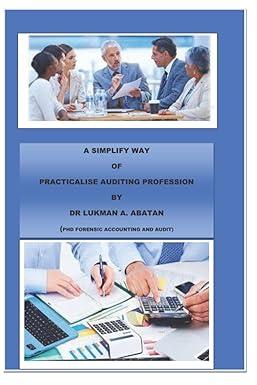Question
Please read the case study below on the differences between equity and liabilities. Decide whether the Class A common (ie. ordinary) shares may be disclosed
Please read the case study below on the differences between equity and liabilities. Decide whether the Class A common (ie. ordinary) shares may be disclosed as part of shareholders equity. Explain the application of relevant passages from AASB 132 and the Conceptual Framework to the Class A Common Shares, making specific connections between wording in in the standards and framework with the features of the shares.
Using the AREA framework, do you agree or disagree with the classification of the Class A shares as equity? In your answer refer to relevant accounting standards.
ANALYSE: (30-50 words) Identify the issue and why it matters. Determine what you need to find out.
RESEARCH: (200-250 words) Present relevant facts and evidence, or issues.
EVALUATE & ANSWER: (200-250 words) Provide your opinion of the themes or issues you have identified, justified by the evidence you have gathered and evlauated.
Cast study adapted from Gunderson, K.E. (2013) Distinguishing between Liabilities and Equity; Two Mini-Cases for Improving Students Critical Thinking Skills in Intermediate Financial Accounting, Journal of the International Academy for Case Studies, 19(3), 51-62.
It was Friday afternoon, and Neil Danford, a new staff accountant at Extua Corporation, had mixed feelings about the memo he just received from the controller of Extua Corporation. Next week he would begin working on a project that could have an immediate impact on the financial position Extua would report to investors and other outside parties. While he was proud to be given such an important assignment, he considered it a bit advanced given that he had only been with Extua Corporation for six months.
Neil was surprised by the esteem his superiors had for him. A circumspect person, Neil felt the other new staff accountants at Extua, who were socially outgoing, would surpass him in climbing the corporate ladder. But his superiors seemed to like his demeanor, and they would sometimes stop by his cubicle to chat, speaking to him as an equal, an intimacy they did not share with the other college graduates.
This new project involved classification of a special type of common stock Extua issued to acquire a company that had previously been one of Extuas suppliers. Negotiations resulted in an agreed price of $5 million, and the previous owners accepting Class A common shares as payment for their company. Further details about these shares, and other aspects of Extuas financial structure, are as follows:
At December 31st, 2016 Extua Corporation has various forms of debt outstanding including secured bank loans and debentures. Extua has no preferred stock, but has two types of common shares outstanding, Class C and Class A. There are one hundred million shares of Class C common stock outstanding. Each share entitles the holder to one vote on ballot items at the companys annual meeting. The shares are transferable without restriction and are actively traded on the Australian Stock Exchange. In addition, Extua had the following Class A Common shares outstanding:
$5 million - Class A Common Stock (100,000 shares of $50 per share).The shares are non-voting, do not share in dividends, but have liquidation rights at par with the Class C common shares. The shares were issued 1 December 2016 and are subject to mandatory redemption on 1 December 2018 at $57.245 per share, or a total of $5,724,500. The shares will be accreted to their redemption value using the effective interest method. The company may, at its option, pay the $5.7245 million redemption amount in cash, shares of Class C common stock (based on the market price for the common stock at the time of redemption), or any other form of consideration deemed appropriate by the board of directors of the company.
Extua Corporation officials would like to report the Class A Common shares in the shareholders equity section on the 30 June 2017 balance sheet. They reason that since the stock is issued in the form of common shares, and since they may discharge their obligation without payment of any cash, it is therefore justified to report these shares as part of shareholders equity.
Step by Step Solution
There are 3 Steps involved in it
Step: 1

Get Instant Access to Expert-Tailored Solutions
See step-by-step solutions with expert insights and AI powered tools for academic success
Step: 2

Step: 3

Ace Your Homework with AI
Get the answers you need in no time with our AI-driven, step-by-step assistance
Get Started


